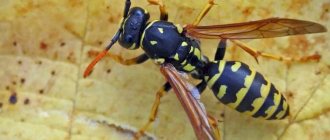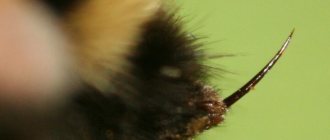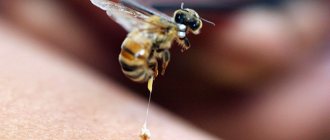A midge bite is often accompanied by unpleasant symptoms, especially when the respiratory tract or visual organs are affected. Most often, residents of central Russia have to deal with insects. Such bites cause a person a lot of discomfort, and sometimes serious danger. Therefore, lovers of outdoor recreation need to know what to do if they are bitten in the eye by a midge, how to relieve swelling, and how to protect themselves and their children from these insects. This will be discussed in more detail in this article.
If a midge bites you in the eye, how can you relieve the swelling?
A little about midges
There are about 1,800 species of midges in nature; they live in all regions of the globe near water sources, rivers and lakes. The lifespan of insects does not exceed a month, but during this time they manage to acquire numerous offspring and feast on the blood of many people. Usually midges gather in large groups, called midges, and in such a “flock” they attack the victim. For females, food is the blood of mammals, humans and birds; males should not be afraid - they feed on the nectar of flowering plants. In order not to suffer from a midge attack, you should know that these blood-sucking insects:
- They are most active during the day, especially from 4 to 6 pm; they sleep at night.
- They live in forest belts, near bodies of water with running water.
- They like to lie in wait for prey near tall grasses and plants.
- They live for about 3-4 months, the lifespan of females of some species lasts up to 3 months.
- They live on all continents except the Sahara and Antarctica.
- They attack a person en masse – with vile attacks, which complicates the situation of the victim.
- They often attack in extreme heat and heat.
What danger does a bite pose to adults?
It all depends on the location of the lesion, including external symptoms. A midge can bite a person in any part of the body, but most often it is the limbs, chest, back, and stomach. Such bites, although they cause considerable discomfort, do not pose a particular threat. When an insect chooses the upper part of the body for its target, there is a risk of developing severe swelling.
Interestingly, in central Russia, the largest population is the black midge - a small midge 1-3 mm long. This type of insect lives near bodies of water and has poisonous saliva. During a bite, a midge does not pierce the skin like a mosquito, but pinches off a piece of flesh. Moreover, the midge manages to do this unnoticed by humans due to its saliva, which contains an anesthetic.
If a midge bites an eyelid, lip, cheek, ear, neck, nose or scalp, the victim will not immediately notice it. Visually, the problem is detected only after some time, when the affected area begins to turn red and the swelling begins to increase. If a midge has bitten the eye and the eye is swollen, swelling appears, and visual acuity may be temporarily limited. In this case, it is important to properly treat and treat the affected area in order to get rid of swelling in a matter of days.
A midge bite can lead to more serious consequences if the patient has an allergic reaction in such life-threatening manifestations as Quincke's edema or anaphylactic shock.
Bite symptoms
A midge bite is more painful for humans than a mosquito bite - the fact is that, unlike mosquitoes, these insects do not bite, but bite off a piece of skin and inject an anesthetic substance into the wound, and since the victim does not notice this immediately, the bloodsucker manages to feast on his beloved food.
Symptoms of an eye bite usually appear within minutes or hours and include:
- Unbearable itching.
- Painful sensations.
- The secretion of tears from the eyes is a protective function of the body that has a cleansing and antibacterial effect with the help of beneficial substances contained in tears.
- Redness of the skin due to dilation of blood vessels is divided into several types:
- Spots of a red hue - single or throughout the body.
- Hyperemia of the entire face.
- Redness around the bitten area.
- Swelling and swelling of the eye.
- Rupture of blood vessels in the eye.
If there is a strong increase in body temperature, headache, dizziness, vomiting and large blisters, you must immediately call an ambulance - such signs may indicate severe intoxication of the body. Failure to provide the necessary treatment can lead to angioedema or anaphylaxis; the most severe consequence of these diseases is death.
How dangerous are midges?
Mosquito and midge bites are significantly different in nature. The first ones stick their thin proboscis into the skin. The latter, biting the surface, let out a little saliva. Female midges feed exclusively on blood. For males, nectar from flowers serves as food.
When a midge bites you, the saliva releases substances that cause pain relief and have a liquefying effect. When the bite site becomes saturated with blood, the midge immediately begins to lick it off. After some time, the anesthesia ends, and the surface around the wound begins to hurt, redness, swelling and often itching or burning are observed. Treatment of a midge bite is somewhat more complicated; in fact, the bite itself can be more painful.
Swollen skin at the site of insect bites is a manifestation of the human body’s protective reaction to a foreign protein in their saliva. In rare cases, an allergy is observed to the bite of midges. Insects can significantly spoil your appearance, especially if they bite you in the eye. Swelling on the face lasts about 5 days. Sometimes a bruise may appear.
Features of manifestation in a child
The consequences of a bite in children are much more severe than in adults, this is due to several reasons:
- The skin of children is softer and more delicate, and the blood vessels are thinner and smaller, so toxins spread through them much faster.
- The baby’s immune defense is not yet strong enough, so the reaction to a bite can be quite severe: the body temperature rises, allergy symptoms appear, which spread from the eye throughout the body, in some cases this leads to breathing problems and suffocation.
- If a midge has bitten a child directly in the eye, the baby may scratch the damaged area vigorously, as a result of which the risk of infection entering the wound will increase.
If a child has a swollen eye after a midge bite, he needs to take an antihistamine and apply the product in the form of a cream or ointment to the affected area. Traditional medicine methods may also be helpful.
Prevention measures
To protect yourself as much as possible from midge bites, you must follow primitive preventive measures:
- If possible, avoid being outside.
- When going outside or going into nature, clothes should cover all parts of the body, and put a mosquito net on your head.
- Treat clothing with insecticide and exposed areas of the body with repellent. These products can be in the form of sprays, lotions and creams. When using chemical protective agents, carefully read the instructions for use to determine whether it is approved for a child.
- You can use an aqueous solution of vanillin by treating your skin and clothing with it.
- Use aromatic oils of clove and lavender.
Advice!
Use a mosquito net when walking your baby in a stroller. If a child is bitten in the eye by a midge, you need to show him to a doctor.
What to do if a midge bites your eye?
When you become aware of a bite to the eye, you should act immediately:
- Apply a special antiphlogistic (preventing inflammation) cream, applying it to the skin around the eye. This helps reduce itching and prevents the formation of swelling.
- Antihistamines to prevent an allergic reaction. Usually taken orally or intramuscularly.
- Drinking plenty of fluids helps remove toxins.
If it is not possible to use pharmaceutical drugs, you can proceed as follows:
- apply grated or cut potatoes to the injured area;
- mashed mint or bird cherry leaves;
- compress with parsley juice;
- natural lemon juice.
The main thing to remember is that a bite to the eye is very dangerous and is fraught with complications, including loss of vision, so after providing first aid you should consult a specialist.
Traditional medicine
If a person fundamentally does not use medications for treatment, or there is no way to quickly get a consultation with a doctor or pharmacy, you can try the following remedies in the first stages:
- Plantain – in the form of gruel or juice. Carefully place a napkin soaked in plantain juice or pulp on the eyelids, being careful not to get inside the eye.
- Parsley - in the form of juice or gruel. Apply only on eyelids. Do not put into the eyes in the form of drops.
- Lather the napkin generously and apply it onto the eyelids with gentle movements, without getting inside. Leave for about 30 minutes and rinse with clean cold water.
- Take alkaline mineral water in the amount of 1.5 - 2 liters per day.
Reasons for the development of an intense allergic reaction
In most healthy people, with normal functioning of the immune system, the site of a midge bite itches and swells a little, but after 3-4 days it goes away without leaving a trace. If we are talking about damage to the neck, eyelids, eyes, lips and scalp, then, in addition to redness, severe swelling occurs. However, these symptoms seem completely harmless in comparison with the course of an allergic reaction to an insect bite.
The main factors influencing increased susceptibility to midge saliva are:
- genetic predisposition;
- pregnancy;
- weakened immune system;
- a history of chronic diseases of the endocrine or urinary systems.
In an adult, allergies can occur against the background of exacerbation of any chronic pathologies. Children are always at risk because their blood vessels have increased permeability, and their immunity is not strong enough due to age.
How to relieve swelling from a bite?
Detailed instructions for quickly relieving swelling after a midge bite in the eye area:
- Do not touch or rub the bitten area and blink as little as possible.
- Urgently take antihistamines and then take one tablet every 3-4 hours.
- Disinfecting the injured area with hydrogen peroxide. In this case, it is necessary to ensure that the product does not get on the mucous membrane. Otherwise, there will be an additional burn.
- Apply a compress of grated fresh potatoes, which must be changed as it dries (about every 2 hours) and left for at least 12 hours.
- Use special eye drops based on naphthyzine with diphenhydramine.
- Lubricate the affected area with antihistamine ointment. This does not exclude a potato compress; you just need to let the ointment absorb.
- Administer a solution of dexamethasone and saline intravenously. If necessary, go to the clinic.
- Next, follow the regimen until the swelling is completely removed: an anti-allergy tablet at intervals of 3-4 hours, ointment and drops every 2-3 hours.
Possible complications after a midge bite
If the treatment measures taken do not bring relief, and the patient’s condition worsens, it is necessary to call an ambulance.
Signs of developing an allergy to an insect bite can be confidently considered:
- chills, fever;
- nausea, vomiting;
- dizziness;
- headache;
- shortness of breath;
- weakness;
- increased blood pressure;
- rash on the body in the form of blisters on various parts of the body.
Such symptoms are characteristic of general intoxication. If these manifestations are accompanied by attacks of suffocation, the patient is diagnosed with anaphylaxis, the consequences of which can be the most unpredictable: from loss of vision to death.
Pregnant women who are not prone to allergies should not be afraid of a midge bite, since the insect's venom is not capable of having a toxic effect on the fetus.
Interestingly, males never attack humans. They, unlike females, are completely harmless and feed on plant nectar. Typically, females select prey by the smell of sweat.
It will not be possible to quickly relieve swelling from a midge bite if an infection penetrates into the lesion. Moreover, the insect itself could have brought it, but most often the complication occurs due to the lack of proper hygiene. Often, a bacterial infection attaches to the wound in children who cannot tolerate the itching and scratch the skin after a bite.
Midges that live in Africa and Asia are capable of carrying dangerous diseases: tularemia, anthrax, cholera, so their bite can be deadly.
What to do if an insect gets into your eye
- 7.1 Video: How to get a midge out of your eye?
First of all, it is important to remember that you should not rub your eye, trying to get the insect out of it as quickly as possible . After such actions, it becomes much more difficult to get it.
The affected eye should be closed, without squeezing your eyes shut, and held there for fifteen to twenty seconds. These actions will give rise to involuntary lacrimation. In this case, you need to try to blink. The tears that come out will help moisten the eye and drive the insect to the corner of the eye. In this case, getting the midge will not be difficult.
Don't rub your eyes to get the insect out
There is no need to try to pull out the midge with your finger, even if your hands have been washed beforehand. You should also not use a dry cotton swab, as it can cause irritation of the eye if it comes into contact with wet mucous membranes, and it can also introduce additional cotton wool into the eye.
Note! The best remedy for removing midges from the eye is a napkin or handkerchief that has been previously moistened with water. Using a damp tissue, you can easily pick up the insect from the edge of your eye without causing irritation.
A damp cloth may help
There is also another way to get rid of an insect in the eye. It is suitable if you have some container at hand, for example, a deep plate or bowl, as well as clean water. After pouring water into a bowl, you need to dip the affected eye into it and make several blinking movements. With this procedure, the midge should be washed out of the eye.
What to do
Most likely, specialized treatment will not be needed. However, if you experience unbearable pain and severe itching, you can try the following natural remedies to relieve swelling from a midge bite.
Rinse thoroughly
It is important to wash the area well with soap and water to avoid bacterial infection or, worse, Morgellons syndrome. Dry with blotting movements without rubbing.
Biting midges have four sharp blades in their mouths that tear the skin, leaving a small open wound susceptible to infection.
After thoroughly cleansing your skin, apply an antiseptic.
Apply apple cider vinegar
Vinegar is a popular natural home remedy that is used for a variety of purposes. It will help reduce swelling, pain, and redness. Soak a cotton swab in a little vinegar (1 part water to 1 part vinegar) and gently apply it to the area until it starts to feel better.
Apply a cold compress
If a midge bite causes swelling and unbearable itching, you may find some relief by applying a cold compress. Add some ice to a damp cloth and place it on the wound. Keep it on the affected area for at least 15 minutes.
The cooling sensation will reduce swelling, numbness of the skin, and relieve itching. Do not apply ice directly to the skin or leave the compress on for more than 20 minutes.
Use anti-itch cream
There are a huge number of pencils, sprays, balms that relieve itching, burning, and pain. Over-the-counter creams such as Cortizone-10 contain hydrocortisone.
Hydrocortisone is a chemical compound that temporarily relieves the itching associated with insect bites. Many creams contain aloe, which helps soothe and moisturize the skin.
Essential oils
Essential oils are an excellent treatment for insect bites. With a few drops you can quickly get rid of swelling and itching. Some will help prevent infection.
The best essential oils for midge bites:
- Lavender;
- Lemon balm;
- Tea tree;
- Chamomile;
- Thyme;
- Mint;
- Eucalyptus.
It is important to remember that oils are extremely effective and should never be applied directly to the skin. Before using, you need to make sure that you dilute it with a quality carrier oil such as coconut, jojoba, almond.
They are great for repelling midges, midges, and other annoying pests.
Take aspirin
Aspirin is a treatment that reduces inflammation associated with midge bites and also helps reduce swelling and itching. Use the back of a spoon to crush the aspirin and mix it with a little water to form a paste. Apply the paste to the injury site and leave for ten minutes.
Take a cold shower
If you're dealing with multiple bites, taking a cold shower for ten minutes will help you feel better. Cold water reduces swelling from midges and other insects.
Soda
Baking soda will help relieve pain after an insect attack. Its solution can reduce swelling of the eyes (1 tsp per glass of water).
Parsley
To prevent your eyelid from itching, you can use parsley juice. A piece of gauze soaked in it is applied to the eyes for several minutes. Such lotions relieve itching, swelling and swelling, and also improve vision due to the high content of vitamin A.
Plantain, mint, parsley and soda
Plantain and mint
Effectively relieves inflammation of the eye and relieves swelling. To do this, the leaves of the plant are washed with cool water, slightly crushed and applied to the affected area. Mint has similar properties. Thanks to its antibacterial effect, it removes swelling and protects the eyes from infection.
Chamomile
You can relieve swelling, itching and soothe irritated eye skin with a decoction of chamomile.
You need to know this! It is dangerous to treat eyes with swelling with hydrogen peroxide, alcohol or vinegar solutions. Such procedures can lead to corneal burns. Alcohol and vinegar lotions are effective when midges have bitten your arms, legs or back.
Cold
Treatment of edema often begins with the use of cold compresses. By applying ice wrapped in a cloth to your eye, you can quickly get rid of the discomfort.
Potato
The consequences of a bite can also be relieved with the help of raw potatoes. It is enough to cut it lengthwise and apply it to the bitten eyelid. After several such procedures, the swelling of the eye will decrease significantly.
Knowing how to relieve swelling of the eyelid when bitten by a midge, you can provide timely assistance to the victim. You should not postpone a visit to the doctor if your health has worsened. This is especially important for children, since their body’s immune defense is much weaker than that of adults. If a child gets a midge in his eye, he should consult a specialist as soon as possible.
How to relieve swelling and itching
If a person constantly scratches the eyelid, then pathogenic bacteria can enter the mucous membrane of the eye, which will lead to conjunctivitis. To avoid this, itching must be eliminated. This can be done both with the help of medications and traditional medicine recipes.
Drug therapy
Medicines will help quickly eliminate itching and swelling. Drops and ointments with an antihistamine effect can be used:
- Fenistil ointment. This drug quickly eliminates swelling and inflammation. Gently lubricate the affected area with ointment, being careful not to get it on the mucous membrane of the eye.
- Hydrocortisone ointment. It will help eliminate swelling, pain and inflammation. In addition, the drug prevents infection of the wound.
- Balm Golden Star. They gently lubricate the eyelid at the site of the bite. The drug reduces pain and swelling.
- Sulfacyl eye drops. They will help quickly eliminate inflammation and swelling. Prevents infection of the visual organs.
- Eye drops Polinadim. They have a pronounced vasoconstrictor and antiallergic effect.
To prevent infections, you can make lotions with Furacilin. It is easy to prepare it yourself from two crushed tablets and a glass of hot water. Lotions should be made from a cool solution.
If these treatment methods do not help, the victim should be taken to the hospital or an ambulance should be called. If a midge has stung a child in the eye, then after first aid he should be shown to a doctor.
Regular baking soda will help reduce swelling of soft tissues. Prepare a solution from a teaspoon of dry substance and half a glass of water, use it for lotions.
Traditional methods
There are many folk recipes that can be used to reduce pain and swelling from various insect bites. In most cases, it is folk remedies that are used when providing first aid in the country or while walking:
- Parsley juice. If any insect stings, the swollen area can be smeared with fresh parsley juice. Thanks to this treatment, redness and swelling are quickly eliminated.
- Some traditional healers recommend using earwax. According to many people, this method really helps and its advantage is that the right product is always at hand.
- For midge bites, you can use plantain. To do this, young leaves are washed with water, crushed a little and applied to the problem area. The leaves should be replaced with fresh ones every 15 minutes until the swelling subsides.
- Mint also has a pronounced analgesic effect. The leaves of this plant are rubbed in your hands and applied to the wound.
- Pharmaceutical chamomile. You can prepare a concentrated chamomile decoction from the herb and a glass of water, and use it for lotions. You can rub fresh flowers between your fingers and apply the resulting mass to your eyelid for 20 minutes.
- Fresh potatoes help a lot. It can be cut into slices and applied to the eye until the swelling subsides. Or you can peel the root vegetable, grate it, wrap the pulp in gauze and apply it to the problem eye.
- Regular toothpaste will help relieve pain quickly. It is applied to the area around the wound using a cotton swab. You need to make sure that the paste does not get on the mucous membrane of the eyes, as it will cause severe irritation.
- A piece of cotton wool or bandage is generously soaped with ordinary laundry soap with a fat content of at least 70%, then applied to the swollen eyelid. Keep the lotion for at least 15 minutes. The eye must be covered. After the procedure, the eyelid is washed with cool water.
- Apply a piece of fresh cucumber to the bite site and leave for at least 15 minutes.
- Dandelion leaves can be used as first aid. They are pre-washed and crushed by hand until the juice is released. Apply the sheets to the eyelid and secure with adhesive tape.
- Apply onion or garlic juice to the affected area using a cotton swab. Care must be taken to ensure that the juice does not get on the conjunctiva.
- A stung eyelid can be wiped with a slice of lemon. This will reduce itching and pain.
- Cooled cabbage leaves are applied to the eye, they help remove swelling and inflammation.
- Bird cherry leaves have a good anti-inflammatory effect. They are kneaded with your fingers and applied to the problem eyelid.
- Apple cider vinegar helps a lot. Prepare a solution from a tablespoon of vinegar and half a glass of water. Soak a napkin in it and apply it to your eyes.
The affected eye can be washed frequently with strong tea leaves or concentrated sage infusion. In this case, only solutions at room temperature are used to wash the eyes.
Duckweed has a strong antihistamine effect. To relieve allergy symptoms, the victim is recommended to apply fresh duckweed to the wound.
Swollen eyelid from a midge bite - how to treat?
The site of an insect attack can pass in a couple of days. How much the eyelid will swell from a bite, and how long the swelling will last, depends largely on the sensitivity of the body, the degree of its sensitization, the functioning of the immune system, and the level of hormones. In addition, the presence of chronic, latent diseases of a bacterial or viral nature is also important.
If an insect has bitten the eye, it is first important to remove the remaining insect secretions from the mucous membrane. To do this, the organ is washed with sterile water. If distilled or injected is not available, use regular boiled water, cooled to room temperature.
We provide first aid to the victim after a bite
Timely provision of first aid is a prerequisite to reduce itching and relieve swelling of the skin. To prevent the development of complications, immediately after a midge bite, the following measures must be taken as quickly as possible:
- Rinse the affected area.
- Treat the bite with any antiseptic (“Furacilin”, “Chlorhexidine”, “Miramistin”).
- Cover the eye with a sterile bandage and apply cold to it for several minutes - this should be done to eliminate itching and relieve swelling.
- Give the victim an antiallergic drug and plenty of fluids, which will help remove toxins that entered the body with the insect bite.
After first aid, the eyelid should be anointed with a soda solution or ointment with antihistamine components.
Advice! In the first days after a bite, it is not advisable to wash your face with hot water: this will only increase the itching.
Home remedies to relieve itching and swelling
If the medications necessary to treat a swollen eye after a midge bite are not available, you should use natural remedies that are usually found in every home. If the bite site continues to swell, the following will help stop it:
- compresses with freshly squeezed parsley juice;
- cabbage leaf;
- menthol mouthwash;
- pieces of fresh potato or cucumber;
- a paste of plantain leaves, mint and lemon balm.
For further therapy, homemade infusions and herbal decoctions are used. An important condition is the absence of components that are potential allergens. For example, honey infusion with geranium, according to reviews, is a very effective remedy that relieves swelling of soft tissues, including after insect bites. But people who suffer from individual intolerance to honey cannot use it.
Among alternative methods, the use of essential oils of lemon, tea tree, and mint is considered popular. These products are not used in their pure form. Before smearing the swollen eyelid after a midge attack, mix a few drops of ether with the same amount of sunflower, sea buckthorn or olive oil.
To maximize the removal of toxic substances after an insect bite, relieve itching and inflammation, lotions made from chamomile decoction, rosehip infusion or strong black tea help. They will not cause harm, even if they get on the mucous membranes of the eyes.
Effective pharmaceutical medications against eye inflammation
Compared to folk remedies, traditional medicines are a more reliable tool. Among pharmaceutical preparations there are many fast-acting ointments and solutions that can relieve severe swelling overnight. However, you cannot prescribe them yourself, because most have side effects and have a number of contraindications.
If a midge bites you in the eye or eyelid, you can use:
- lotions with Novocaine (0.5%);
- anti-allergic non-hormonal creams and gels “Fenistil”, “Cinovit”, “Advantan”;
- ointments containing corticosteroids: Hydrocortisone, Triderm, Sinaflan.
If the patient’s general condition worsens after a midge bite, it is mandatory to use:
- antihistamines in tablet, drop or injection form (Tavegil, Suprastin, Claritin, Erius, Loratadine, Zyrtec);
- diuretics to relieve edema (“Furosemide”);
- glucocorticoids (“Dexamethasone”, “Hydrocortisone”, “Prednisolone”).
The doctor may also prescribe additional symptomatic treatment. For example, pain or high temperature are grounds for prescribing drugs with paracetamol or ibuprofen. In addition, after an insect bite, to protect the mucous membrane of the eye, it is recommended to drip eye drops “Sulfatsil”, “Taufon”, “Oftalmoferon”, “Tsipromed”.
You cannot use lotions based on alcohol, vinegar, or hydrogen peroxide to relieve swelling of the upper or lower eyelids. These components irritate the mucous membrane and can burn the cornea if they accidentally get into the eye.
In the event of a bacterial infection at the site of the midge bite, the use of additional drugs will be required, among which the most popular and effective are:
- antimicrobial and anti-inflammatory ointments (tetracycline ointment, Levomekol, Oflokain, Betadine, Levosin);
- antibiotics in tablets (“Azithromycin”, “Clarithromycin”, “Augmentin”);
- eye drops with antibacterial and analgesic components (Floxal, Diclofenac, Lidocaine).
As soon as the swelling from the midge bite is removed and the infection is eliminated, the patient is prescribed safe healing ointments, which are usually used until complete recovery. The ointments “Bepanten”, “Panthenol”, “Solcoseryl”, “Methyluracil” have a regenerating effect.
What is prohibited?
As already noted, alcohol and vinegar lotions should not be applied to the eyelid, the swelling of which was caused by an insect bite. You should also use cosmetics with extreme caution. Soothing lotions and emulsions can provoke an allergic reaction and complicate the course of the disease.
Under no circumstances should you scratch an itchy eyelid. It is especially important to monitor the movements of young children. If the patient was undergoing antibacterial treatment before the midge bite, there is no need to interrupt the medications - giving up antibiotics will not speed up the regeneration processes.
Consequences
In what cases is treatment and relief of swelling from a midge bite contraindicated using traditional methods? It is prohibited to use improvised means after an attack by blood-sucking insects if the victim:
- large affected area (for example, on the entire leg, arm, half of the face);
- a pronounced allergy has arisen (especially in young children);
- body temperature has increased (even slightly);
- blood pressure has increased or, conversely, decreased (especially in elderly patients and people with cardiovascular diseases);
- there is a general pallor of the skin (except for the places where the bite was made);
- enlarged lymph nodes;
- heart rhythm is disturbed;
- severe intoxication of the body occurred;
- severe swelling occurred in the area of the visual organs, including lacrimation and suppuration of the eye.
In such cases, self-medication is undesirable. To prevent unwanted consequences, you should definitely consult a doctor. In serious situations, the victim may need to be hospitalized.
Treatment of a child
The symptoms of a midge bite in a child are identical to those of an adult. It should be remembered that the speed of their development is much faster, and the severity of the condition is more pronounced than in an adult. Therefore, the child requires early examination by a doctor and prescription of medication if symptoms become more severe. The child’s body cannot cope with developing intoxication on its own.
If you are bitten by a midge, especially in the skin of the eyes, you should not:
- Perform warming procedures (compresses, hot water).
- Comb the skin vigorously with your hands.
- Take antihistamines above the daily dosage.
- Place ointments and creams with an antihistamine effect for external use inside the eye.
- If self-treatment has no effect, ignore examination by a specialist.
What not to do
You need to know not only how to provide first aid for a midge bite, but also how not to harm yourself. In such cases, it is strictly prohibited:
- Comb or rub the eye.
- Use dubious traditional methods for treatment.
- Apply hormonal medications directly to the wound. In this case, a strong burning sensation occurs and healing slows down. Hormonal ointments can only be applied to the surrounding area.
- You cannot refuse treatment with antihistamines.
- If complications are observed and the doctor has prescribed antibiotics, you should take them in the indicated course.
- You should not start taking antibacterial drugs or using any hormone-based medications without a doctor’s prescription.
- Apply dry heat to the eye. In this case, the poison will spread throughout the tissues and the swelling will noticeably increase.
If the victim’s condition worsens every minute, you should immediately call an ambulance. It must be remembered that a mosquito bite can even be fatal.
In some cases, a person’s condition after insect bites is very serious and hospital treatment is required.
Manifestations of insect bites in children
There are about two thousand species of midges in nature. These insects are most active during daylight hours. The nature of the bites is somewhat different from those inflicted by their other relatives. Upon contact with a person, the midge plucks off a piece of skin or mucous tissue and releases its toxin (poison), which is an allergen, anticoagulant and anesthetic at the same time. Due to the analgesic properties of the salivary secretion applied by insects to the surface, you cannot immediately feel the bite; during active games, the child will not even pay attention to it. Signs of damage appear within a few minutes after the bite or even several hours after it.
In the eye that was bitten by a harmful midge, the child develops an inflammatory reaction. The degree of its severity depends on the individual characteristics of the body, the specific type of midge, the age of the child (infants are more susceptible to damage), and the resistance of the immune system.
A bite manifests itself with the following classic symptoms:
- a wound in the form of a dot in the affected area;
- swelling, swelling of the eye, its redness;
- severe itching, causing the child to scratch the eye, burning, pain;
- lacrimation;
- a bruise, blister, or spot may appear in the area of the bitten eye;
- prolonged healing (more than two weeks).
In severe cases, after a bite has occurred, signs of intoxication and enlargement of regional lymph nodes are observed. If a child is prone to allergies, a skin rash may appear at the same time, body temperature may rise, and the heart rate may increase. Blood pressure changes (hypotension). Angioedema and anaphylactic shock may develop.
Intensive scratching of the eyes, especially with unclean hands, leads to infection of the wound left from the bite. In this case, pain and swelling intensify, and massive purulent discharge from the eyes appears.
Dangerous infectious complications.
Small insect pests can lead to the development of serious infectious diseases.
The bite of the onchocerciasis midge is complicated. The incubation period is about 1 year. Manifested by the formation of fibrous growths on the joints, weakness, headache, hyperthermia.
Leprosy is not a common, but dangerous disease that affects the dermis (pathological formations on the skin, scales) and the peripheral nervous system.
The cutaneous form of anthrax is manifested by ulcerations, hypothermia, bleeding disorders, and kidney failure. The septic form can lead to a lethal (fatal) ending.
How to recognize bites, their main symptoms
Female midges, or midges, feed on the blood of people or animals to procreate. Unlike mosquitoes and other blood-sucking insects, they do not pierce the skin, but tear off a piece of skin, which is much more unpleasant and dangerous. When bitten, these insects release a special substance, which is both an analgesic and prevents blood from clotting for a certain period of time. Therefore, often a child even notices immediately that he has been bitten, since the bite site is anesthetized, and only after a walk, already at home, does he begin to feel itching, pain or burning at the bite site.
How long does a midge bite take to heal?
How long the swelling from a bite lasts depends on your health condition. On average this is:
- For mild skin reactions – from 1 to 4 days.
- For local allergies – from 4 days to 1.5 weeks.
- For an initially severe allergic reaction – from 1 to 2 weeks.
In addition to allergies, the duration of the presence of edema can also be affected by the location where it is located and the rate of metabolic processes in the body. With proper treatment and supportive care, intense swelling in most cases is relieved within 1–3 days; further recovery gradually eliminates the remaining symptoms within 10–14 days. How long the bite lasts and how long it takes for it to heal completely so that not a trace remains of it depends on the speed of skin cell regeneration, which is also highly individual and can take from a week to 1 month or more.
Which doctor should I contact if I have a midge bite?
Where to go if you are bitten by a midge depends on the situation:
- If you are bitten and have a violent reaction right now, you can go to the nearest trauma center.
- If allergies develop and there is a threat of anaphylactic shock, you can call an ambulance.
- When some time has already passed since the bite and your health allows it, contact a therapist at the clinic to which you are attached, he will give you a referral to the right specialist.
In commercial clinics, you can immediately make an appointment directly with a dermatologist or allergist.
If you already know that you are allergic to insect bites, prepare for the summer season in advance.
- Always have a first aid kit with a standard set of supplies on hand.
- Visit an allergist and, based on tests and tests, develop with your doctor an individual approach to relieving your symptoms.
- Add the necessary supplies to your first aid kit and take them with you when you go outdoors.
- Just in case, write down in your smartphone all the necessary addresses and telephone numbers of medical institutions near your dacha or the place where you plan to spend time outdoors and may be bitten.
These measures may seem too difficult to implement or completely unnecessary, but if you or your loved ones have allergies that can be life-threatening, then they are more than justified.
Despite the frightening prospects of midge bites, they can go away without any treatment at all in a few days, with virtually no symptoms other than mild itching and redness. Any reaction is individual, so the approach to treatment must be determined according to the situation and, preferably, together with a doctor.
conclusions
To quickly and safely remove an insect from your eye, you need to remember a few basic points:
- if a midge penetrates the organ of vision, do not rub your eyes with your hands and try to blink less;
- The insect should be removed with clean hands, without using sharp objects;
- if it was not possible to eliminate the midge at home, you should contact a medical institution for specialized care;
- to prevent the development of complications, follow the recommendations of your doctor and take prescribed medications;
- Before using alternative medicine recipes, you must ensure that there is no allergic reaction.
Was the article helpful?
Rate the material and the author!
( 2 ratings, average: 5.00 out of 5) And if you have questions or experience and want to speak on this topic, write in the comments below.
What not to do?
- If you have a bitten eye, you should never scratch the bite site, as this can lead to severe irritation and inflammation of the mucous membrane of the eye due to infection.
- Hormone-containing ointments should not be applied to the bite site - only around the wound. Antibiotics should not be used without a doctor's prescription. It is strictly forbidden to squeeze out midge venom or burn the wound with alcohol. This not only damages the skin, but also increases the overall intoxication of the body.
- You should also not perform warming procedures (compresses, hot water). It is necessary to refrain from taking antihistamines above the daily norm.
- It is absolutely impossible to ignore visiting a specialist if there is no effect from self-treatment.
First aid
If a midge bite occurs, help should begin with:
- Wash the bite site with plain water and soap.
- Dry with a clean cloth.
- Applying cold to the bite site.
- Taking an antihistamine by mouth to reduce itchy skin and reduce the risk of an allergic reaction.
How to relieve swelling from a bite:
- Apply antibacterial, antiallergic eye drops into the eyes.
- Make cold lotions with tea leaves or ice cubes.
- Rest your eyes by covering them with a blindfold or wearing sunglasses.
- Rinse your eyes with clean water if a midge gets into it.
If you are bitten in the eye by a midge, you can find out how to relieve the swelling by calling an ambulance.
Review of medications
What to do if your eye is swollen from a midge bite becomes clear from the previous sections - take the necessary medications, the most effective and popular of them are:
- Suprastin tablets stop the production of histamine, eliminating the negative manifestations of an allergic reaction. The effect of the drug can be noticed within a couple of hours.
- Polynadim - sold in the form of drops, prevents inflammatory processes, eliminates symptoms of hypersensitivity, removes swelling and promotes constriction of blood vessels.
- Hydrocortisone eye ointment, the active ingredient of which is hydrocortisone acetate. The drug has an antihistamine, disinfectant, decongestant and antipruritic effect. The product is applied behind the eyelid 2-3 times during the day. When using several medications, the ointment can be used only 15 minutes after using eye drops.
- Fenistil - available in the form of capsules, gel and drops. The product should be applied to the site of the midge bite with a thin layer and anointed with the eye - perform the manipulation 2-4 times a day, the drug will begin to act in no more than 4 hours.
- Tavegil - comes in the form of tablets and solution for injection into a muscle or vein. Used to relieve signs of an allergic reaction, normalize blood pressure, relieve itching and inflammatory processes.
- Sinaflan is an ointment in a tube based on fluocinolone acetonide. Prescribed for insect bites, severe itching, psoriasis, burns and various dermatoses. Before treating the midge bite, you should rinse your eye and gently dry it with a towel.
- Loratadine - in the form of tablets or syrup. Helps block histamine H1 receptors and is also used to relieve symptoms of midge bite allergy such as eye swelling, watery eyes, constant sneezing, hives and itchy skin.
- Dexamethasone – can be in the form of eye drops, tablets and injection solution. The drug exhibits antihistamine, antitoxic, desensitizing, anti-inflammatory and anti-shock properties. If the victim has a swollen eye after a midge bite, the doctor should advise how to treat such symptoms; most likely, eye drops will be prescribed.
- Furosemide is a diuretic and can be prescribed by a doctor as a decongestant.
- Furacilin is sold in the form of a solution, ointment and tablets for preparing a solution. The medication is intended to relieve inflammation, destroy harmful bacteria, and treat damaged skin areas.
Sources
- https://mcvdh.ru/zabolevaniya/ukusil-v-glaz.html
- https://www.ayzdorov.ru/lechenie_ykys_moshka.php
- https://GdeKlop.ru/moshki/ukus-v-glaz/
- https://obnaruzhil.ru/moshka/v-glaz-ukusila.html
- https://ukusinfo.ru/simptomi-ukusy/ukusila-moshka-glaz.html
- https://apest.ru/moshki/moshka-ukusila-v-glaz/
- https://rci76.ru/muhi-i-moshki/ukusila-moshka-opuh-glaz.html
- https://Dezoff.ru/nasekomye/ukus-moshki/
- https://WikiParazit.ru/babochki-i-moshki/chto-delat-esli-moshka-ukusila-v-glaz.html
[collapse]











